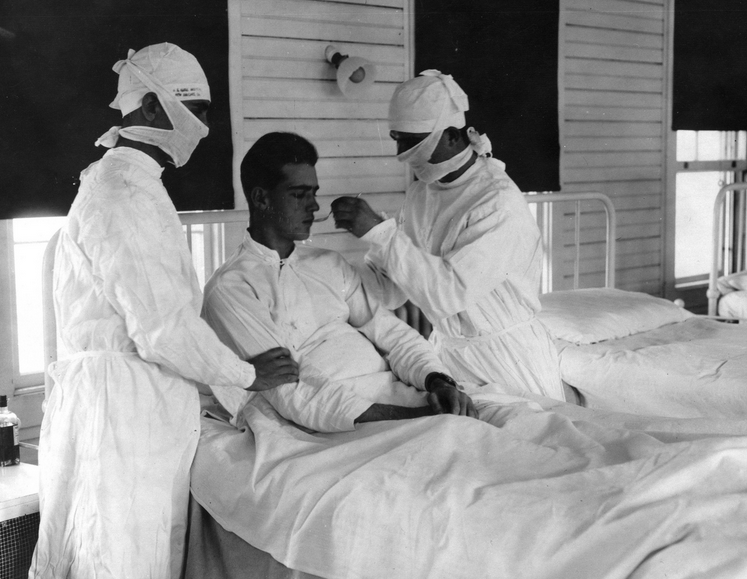Advertisement
A Surprising New View Of Flu: Rethinking The 1918 Pandemic

By Richard Knox
Guest Contributor
Ever since 1918, the world has wondered why a novel flu virus touched off an explosive pandemic that killed as many as 50 million people – most of them healthy young adults — and whether it could happen again.
Flu researchers today report some surprising news: They say the 1918 virus was no super-bug. Instead, its deadliness had to do with how very different it was from the flu viruses circulating 25 or 30 years before, when the young adults of 1918 were first exposed to the flu.
Indeed, the new study says it’s that first childhood exposure that determines how people will fight off – or fall prey to – every other flu virus they will encounter in a lifetime.
That’s a very different way of looking at flu, both pandemics and regular seasonal outbreaks.
Much of the current emphasis is on the virus itself. Scientists around the world are doing controversial “gain-of-function” experiments – adding and subtracting pieces of genes from flu strains to see what mutations make some viruses so virulent.
Instead of focusing on flu virus itself, authors of a paper published Monday in the Proceedings of the National Academy of Sciences say scientists and public health experts should pay attention to the vulnerabilities of different age groups to any new flu virus – and how those immune gaps might be filled in by targeted vaccine strategies.
“Childhood exposure seems to give kick-ass immunity to that kind of flu virus for many, many decades,” says evolutionary biologist Michael Worobey of the University of Arizona, the paper’s lead author.
But if another virus comes along that’s a complete mismatch to that first-exposure virus, the immune system misfires. It can’t mount an effective response to the new threat.
That’s what Worobey and his colleagues say happened in 1918. People around the world who were in their 20s and 30s back then had been exposed in childhood to a flu virus type called H3N8 that originated in Russia in the 1880s.
But the 1918 flu was a different type altogether, called H1N1. It’s the ancestor of the predominant flu virus circulating today and a mutant form that caused the relatively mild pandemic of 2009.
The 1918 virus was a mashup of a human flu virus that emerged after the turn of the 20th century and a bird flu virus circulating in the years just before 1918. (Worobey recently reported that the bird flu viral genes may have come from an equine virus that caused a devastating epidemic in horses in the 1870s.)
That explains, Worobey says, why 10- to 15-year-olds did not die in huge numbers in 1918. Their first flu-virus exposure was to an H1-type virus.
And older adults in 1918 probably were protected by residual immunity to an H1N1-type virus they encountered in childhood. Those most protected were born before 1834, so they would have been at least 84 in 1918. They lived through a flu pandemic in the early 1830s.
“Immunity explains the death rates rather exquisitely,” Worobey said in an interview. In other words, there doesn’t need to be some mysterious X factor hiding in the flu virus’s eight genes to explain lethality.
“What happened in 1918 is some really bad luck,” he says. “You were rounding up a cohort into World War One Army camps who happened to have been exposed as kids to the wrong virus to protect them against an H1N1.”
That notion is different from many scientist’s favorite hypothesis – that something about the 1918 virus touched off a so-called “cytokine storm” – an over-reaction of the immune system that actually kills victims, rather than the virus itself.
The cytokine-storm theory points to “intrinsic properties of the virus itself,” Worobey says. And if that’s true, “we’re pretty much at the mercy of the virus and our own biology.”
But so far scientists haven’t been able to pin down anything about the 1918 virus that explains why it was so different. And Worobey says it doesn’t make sense that 30-year-olds would be subject to the cytokine storm reaction when 18-year-olds weren’t.
The new paper also helps explain mortality patterns from two worrisome bird flu viruses currently circulating in humans – H5N1 and H7N9. The former mainly kills younger people, while most fatalities from the latter are in older people. It may have to do with the viruses people were (or weren’t) first exposed to.
And it also may explain why one of the two current seasonal flu viruses, called H3N2, is 18 times more lethal among elders than among young people. Today’s elders didn’t encounter anything similar when they were growing up.
There is a heartening aspect to all this. If vaccine researchers focus on the immunologic blind spots of different age groups, they might design vaccines to make up for those vulnerabilities.
Worobey thinks that’s possible – but would require a big change in vaccine strategy. Flu vaccines aim at two lollipop-like molecules that stick out of the surface of viruses, proteins called hemagglutinin and neuraminidase. (They’re the different types of “H’s” and “N’s” that give flu strains their names.)
Current flu vaccines target the head of the H or N lollipop. But Worobey thinks it might be better to aim at the stalk, which doesn’t change as much over time. That might not prevent someone from getting the flu as well as current vaccines – but it might give long-lasting protection against dying of flu.
“By being very smart about it, we might be able to get a good immune response to a new virus that was a mismatch of the person’s initial immune response to flu,” Worobey says. “But we’re not there yet.”
Boston-based journalist Richard Knox has covered medicine, health and science for National Public Radio and The Boston Globe.